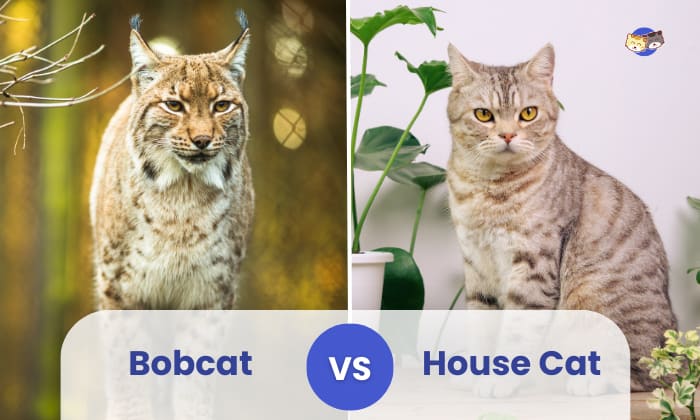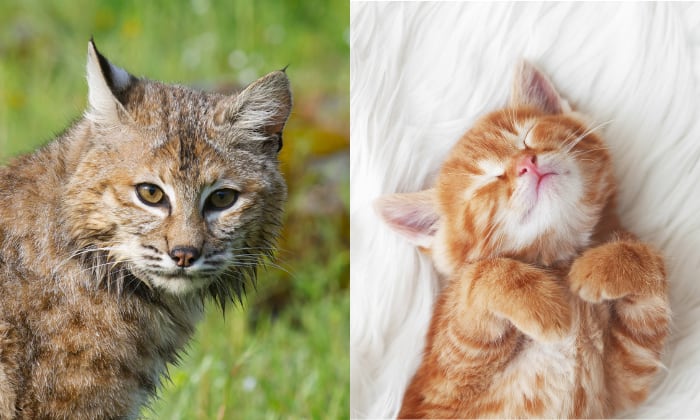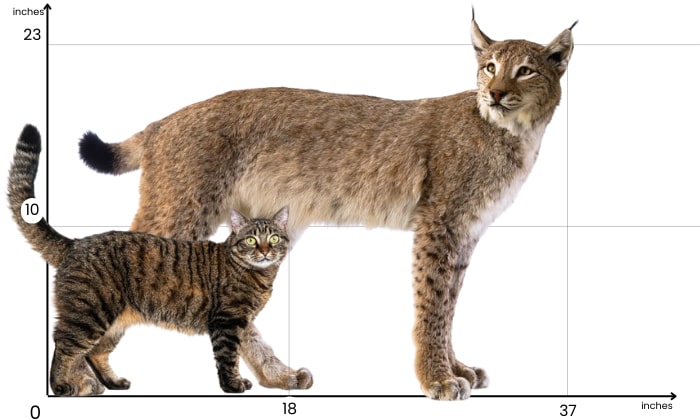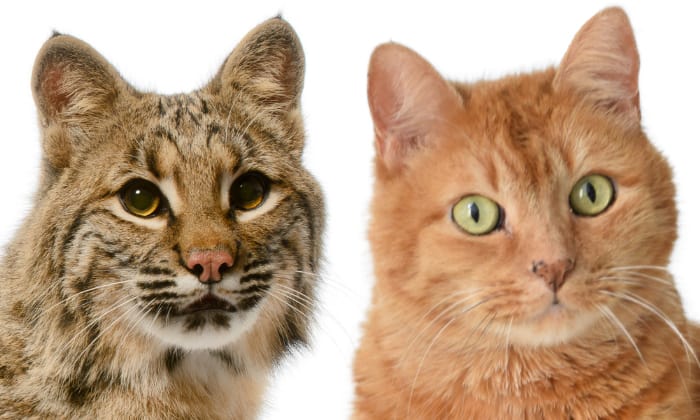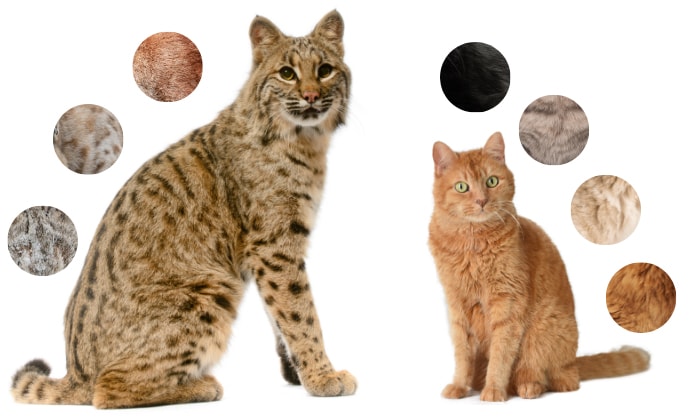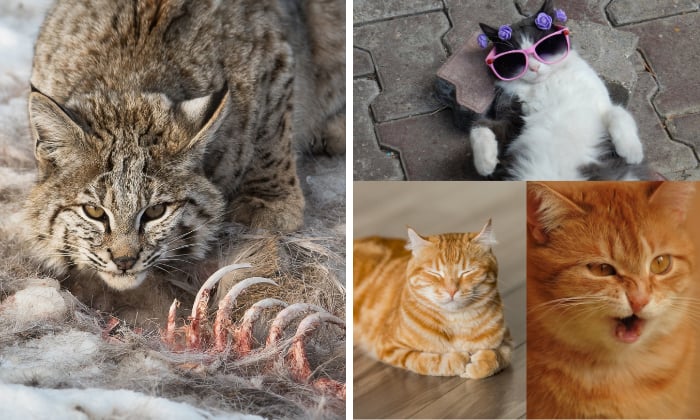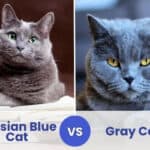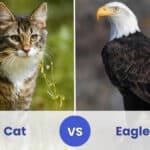Whether it’s your friend’s house or the streets, house cats can be found everywhere. Bobcats, on the other hand, are elusive. Even if you did spot a bobcat in the woods or your backyard, you would probably mistake it for a cat.
Despite their similarities, bobcats do not interact with humans like house cats do. Experts do not encourage raising them as pets. Before you welcome a cat-like creature into your home, check out this article to learn the difference between a bobcat vs. house cat.
| Attributes | Bobcat | House Cat |
| Category | Wild | Domesticated |
| Origin | North America | Middle East |
| Lifespan | 7 years | 10 to 20 years |
| Average Weight | 35 to 40 lbs | 8 to 15 lbs |
| Average Height | 16 to 23 inches | 10 inches |
| Body length | 37 inches | 18 inches |
| Tail length | 6 inches | 6 to 12 inches |
| Coat pattern | Spotted | Solid, bicolor, tricolor, with color points, or in the case of tabby cats, spotted |
Table of Contents
Overview
A bobcat is among the four species of lynx inhabiting the deserts, grasslands, forests, and swamps of North America. However, these wild cats are known to prey on rodents, rabbits, birds, and squirrels in urbanized areas.
These nocturnal, solitary creatures take off at the sight of humans, which explains why they are rarely seen.
Cats and humans reportedly have relationships dating back 10,000 to 12,000 years ago, at a time when one of the earliest civilizations was thought to have begun in the Fertile Crescent. Thanks to the development of agriculture, farmers discovered that cats hunted down rodents that consumed the resident’s food stock.
This led to cats being taken on ships, a decision that facilitated their spread and domestication.
Let’s get into the details of the bobcat vs regular cat comparison in the next section of this article!
How to Identify a Bobcat From a House Cat
1. Body Size
- The average size of bobcat breeds is much larger and heavier than domestic cats. They are roughly 37 inches in length and between 16 to 23 inches in height. Besides appearing more muscular, their legs are longer in general.
- If you look closely, bobcats have back legs that are even longer than their front legs, while domestic felines have limbs that are roughly the same size. This feature allows bobtails to jump and create a “bobbing” motion when they run. However, that’s not how they got their name.
- These wild cats happen to have short “bobtails” that are only six inches long. On average, house cat tails are 6 to 12 inches in length.
Nevertheless, you can’t simply identify felines based solely on size comparison. Some bobcats are smaller than average.
It is also worth noting that some feline breeds have short tails similar to bobcats, such as the American Bobtail and Kurilian bobtail.
2. Facial features
By looking at bodies of research that show a bobcat compared to a house cat in photographs, you will also see that the former has squarish muzzles, ruffs on the cheeks, and tufted ears. In contrast, cats typically have rounded faces and no ruffs.
3. Coat
Every bobcat breed can have either light gray, reddish-brown, yellow-brown, or buff-brown coats. But what makes them distinct is that they also feature spots on their back, chest, and underside, allowing them to blend with their surroundings.
For this species, solid colors are rare, and striped coats do not exist. In other words, there is no such thing as a tabby bobcat.
Cats tend to have coats with a wider range of colors and patterns, depending on the breed. Typically, they come in brown, fawn, black, cinnamon, cream, white, and red.
Although some cats have solid colors, it is not uncommon to find those with bi- or tri-color, as well as tabby, tortoiseshell patterns. Others have darker colors concentrated on the face, paws, and tails—a coat pattern called “color point.”
4. Demeanor
Even today, some homeowners keep cats at home both as companions and as a means to get rid of mice. They can stalk, pounce, and, sometimes, kill their prey but not necessarily eat it. After all, their owners provide them with food.
While cats have long been domesticated, the level of interaction that they give with their fur parents tends to vary. Like humans, some felines are a bit more introverted while others are extra-affectionate.
Bobcats, on the other hand, are territorial. Using feces and urine, a male bobcat typically marks its territory that covers up to 30 square miles. Meanwhile, a female has personal territories of up to five square miles and can cross a male’s territory.
Experts observe that two bobcats of the same gender tend to be aggressive toward each other. As excellent hunters, they can move quickly and quietly in chasing down their prey. Bobcats rarely eat domestic pets, though farm animals can become their targets.
So, are bobcats dangerous to humans?
There are hardly any reports on conflict between humans and bobcats. In an encounter, they would likely run away instead of attacking you. Still, it is best not to provoke these wild felines as they might turn hostile.
5. Licensure
Since bobcats are considered wild animals, they should not be treated as pets. Those who intend to care for bobcats must obtain a license to do it.
Pet owners do not need licenses to adopt or bring home a homeless kitten. Nevertheless, some animal shelters conduct home visits to check your residence. Also, note that you can only adopt if you are 18 or older, which means that the adoption facilitator may ask for your ID.
Conclusion
As you learned in this bobcat vs. house cat article, the two felines have similarities. Hence, it’s easy to mistake one for the other.
We know that domestic cats are irresistibly cute. But before approaching a stray feline in your neighborhood, look at its size first. Remember that the average bobcat size is a lot larger than a domestic cat.
If you’re still unsure, look at the coat patterns and colors, as well as its facial features.

I pursued veterinary studies at the University of Kansas. After several years of practice, I established a veterinary clinic in Kansas. When Michael extended an invitation with a vision that went beyond emergency support – sharing of caregiving information for guardians to create the best living environment for cats, I didn’t hesitate to join the organization.
My role here involves verifying the information presented on the official website. With my experience, I believe the information provided is entirely accurate. If you have any concerns, please feel free to reach out to me


